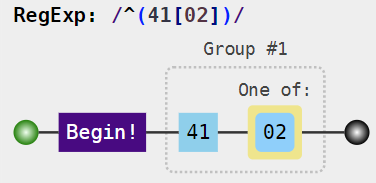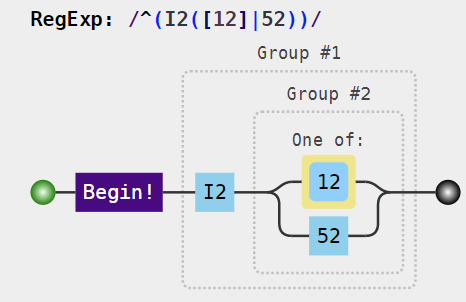
Interpret regular expressions
Source:vignettes/Interpret_regular_expressions.Rmd
Interpret_regular_expressions.RmdClasscodes objects (as described in
vignette("classcodes")) use regular expressions to
classify/categorize individual codes into groups (i.e. comorbidity
conditions). Those regular expressions might be hard to interpret on
their own. Several methods are therefore available to aid such
interpretation of the classcodes objects.
visualize()
A graphical representation of a classcodes object is created by
visualize(). It will be showed in the default web browser
(requires an Internet connection; not available within this
vignette).
visualize(charlson)Visualization of all groups (comorbidity conditions) simultaneously
might lead to complex figures. We can focus on a specific group
(comorbidity) by the group argument. How is myocardial
infarction codified by regex_icd9cm_deyo?
visualize(charlson, "myocardial infarction", regex = "icd9cm_deyo")
Hence, all ICD-9 codes starting with 41 followed by
either 0 or 2 will be recognized as myocardial
infarction according to icd9cm_deyo. The corresponding
regular expression for ICD-10 is:
visualize(charlson, "myocardial infarction", regex = "icd10")
Such codes should start with I2 followed by either
1, 2 or 52. The vertical bar
| (in the regular expression of the heading) indicates a
logical “or”. See ?regex for more details on how to use
regular expressions in R (Perl-like versions are currently not
allowed).
summary()
An alternative representation is to list all relevant codes
identified by each regular expression. This is implemented by the
summary() method for classcodes objects. Note, however,
that the regular expressions are stand alone in each classcodes object.
Hence, there are no static look-up-tables to map individual codes to
each group. We therefore need to specify a code list/dictionary of all
possible codes to be recognized by those regular expressions. Then
summary() will categorize those and display the result.
Common code lists are found in the decoder package
and are accessed automatically through the coding argument
to summary(). Hence, there is a “keyvalue” object
icd10cm with all ICD-10-CM codes in
{decoder}:
head(decoder::icd10cm)
#> key value
#> 1 A000 Cholera due to Vibrio cholerae 01, biovar cholerae
#> 2 A001 Cholera due to Vibrio cholerae 01, biovar eltor
#> 3 A009 Cholera, unspecified
#> 4 A0100 Typhoid fever, unspecified
#> 5 A0101 Typhoid meningitis
#> 6 A0102 Typhoid fever with heart involvementWe can use this code list to identify all codes recognized by
charlson with its default classification based on “icd10”.
The printed result (see ?print.summary.classcodes) is a
tibble with each group and a comma separated code list.
s <- summary(charlson, coding = "icd10cm")
#> Classification based on: icd10
s
#>
#> Summary of classcodes object
#>
#> Recognized codes per group:
#>
#> # A tibble: 17 × 3
#> group n codes
#> <chr> <int> <chr>
#> 1 AIDS/HIV 1 B20
#> 2 cerebrovascular disease 430 G450, G451, G452, G453, G454, G458, G…
#> 3 chronic pulmonary disease 69 I2781, I2782, I2783, I2789, I279, J40…
#> 4 congestive heart failure 36 I099, I110, I130, I132, I255, I420, I…
#> 5 dementia 11 F0150, F0151, F0280, F0281, F0390, F0…
#> 6 diabetes complication 204 E1021, E1022, E1029, E10311, E10319, …
#> 7 diabetes without complication 52 E1010, E1011, E10610, E10618, E10620,…
#> 8 hemiplegia or paraplegia 45 G041, G114, G801, G802, G8100, G8101,…
#> 9 malignancy 961 C000, C001, C002, C003, C004, C005, C…
#> 10 metastatic solid tumor 47 C770, C771, C772, C773, C774, C775, C…
#> 11 mild liver disease 38 B180, B181, B182, B188, B189, K700, K…
#> 12 moderate or severe liver disease 14 I8500, I8501, I864, K7040, K7041, K71…
#> 13 myocardial infarction 18 I2101, I2102, I2109, I2111, I2119, I2…
#> 14 peptic ulcer disease 36 K250, K251, K252, K253, K254, K255, K…
#> 15 peripheral vascular disease 274 I700, I701, I70201, I70202, I70203, I…
#> 16 renal disease 28 I120, I1310, I1311, N032, N033, N034,…
#> 17 rheumatic disease 348 M0500, M05011, M05012, M05019, M05021…
#>
#> Use function visualize() for a graphical representation.A list with all code vectors (to use for programmatic purposes) is
also returned (invisible) and accessed by s$codes_vct.
Now, compare the result above with the output based on a different code list, namely ICD-10-SE, the Swedish version of ICD-10, instead of ICD-10-CM:
summary(charlson, coding = "icd10se")
#> Classification based on: icd10
#>
#> Summary of classcodes object
#>
#> Recognized codes per group:
#>
#> # A tibble: 17 × 3
#> group n codes
#> <chr> <int> <chr>
#> 1 AIDS/HIV 22 B200, B201, B202, B203, B204, B205, B…
#> 2 cerebrovascular disease 82 G450, G451, G452, G453, G454, G458, G…
#> 3 chronic pulmonary disease 57 I278, I279, J409, J410, J411, J418, J…
#> 4 congestive heart failure 19 I099, I110, I130, I132, I255, I420, I…
#> 5 dementia 23 F000, F001, F002, F009, F010, F011, F…
#> 6 diabetes complication 71 E102, E102A, E102B, E102C, E102W, E10…
#> 7 diabetes without complication 55 E100, E100A, E100B, E100C, E100D, E10…
#> 8 hemiplegia or paraplegia 22 G041, G114, G801, G801A, G801B, G801X…
#> 9 malignancy 525 C000, C001, C002, C003, C004, C005, C…
#> 10 metastatic solid tumor 29 C770, C771, C772, C773, C774, C775, C…
#> 11 mild liver disease 83 B180, B180A, B180B, B180C, B180D, B18…
#> 12 moderate or severe liver disease 11 I850, I859, I864, I982, K704, K711, K…
#> 13 myocardial infarction 15 I210, I211, I212, I213, I214, I214A, …
#> 14 peptic ulcer disease 36 K250, K251, K252, K253, K254, K255, K…
#> 15 peripheral vascular disease 43 I700, I700A, I700B, I700X, I701, I702…
#> 16 renal disease 27 I120, I131, N032, N033, N034, N035, N…
#> 17 rheumatic disease 63 M050, M051, M052, M053, M058, M058A, …
#>
#> Use function visualize() for a graphical representation.There are some noticeable differences. AIDS/HIV for example has only
one code deemed clinically relevant in the USA (thus included in the
CM-version of ICD-10), although there are 22 different codes potentially
used in the Swedish national patient register. There are additional
differences concerning the fifth code position (digits in ICD-10-CM and
characters in ICD-10-SE). Those mark national modifications to the
original ICD-10 codes, which has only 4 positions (one character and
three digits). For this example, the charlson$icd10 column
was based on ICD-10-CM (Quan et al. 2005).
The comparison above thus highlights potential differences when using
this classification in a setting based on another classification (such
as with data from the Swedish national patient register).
If we are interested in another code version, for example as
specified by ICD-9-CM (Deyo, Cherkin, and Ciol
1992) , this can be specified by the regex-argument
passed by the cc_args argument to the
set_classcodes function. Simultaneously, the
coding argument is set to icd9cmd to match the
regular expressions to the disease part of ICD-9-CM classification.
summary(
charlson, coding = "icd9cmd",
cc_args = list(regex = "icd9cm_deyo")
)
#>
#> Summary of classcodes object
#>
#> Recognized codes per group:
#>
#> # A tibble: 17 × 3
#> group n codes
#> <chr> <int> <chr>
#> 1 AIDS/HIV 1 042
#> 2 cerebrovascular disease 69 430, 431, 4320, 4321, 4329, 43300, 43…
#> 3 chronic pulmonary disease 8 490, 500, 501, 502, 503, 504, 505, 50…
#> 4 congestive heart failure 15 4280, 4281, 42820, 42821, 42822, 4282…
#> 5 dementia 14 2900, 29010, 29011, 29012, 29013, 290…
#> 6 diabetes complication 12 25040, 25041, 25042, 25043, 25050, 25…
#> 7 diabetes without complication 20 25000, 25001, 25002, 25003, 25010, 25…
#> 8 hemiplegia or paraplegia 13 34200, 34201, 34202, 34210, 34211, 34…
#> 9 malignancy 628 1400, 1401, 1403, 1404, 1405, 1406, 1…
#> 10 metastatic solid tumor 30 1960, 1961, 1962, 1963, 1965, 1966, 1…
#> 11 mild liver disease 7 5712, 57140, 57141, 57142, 57149, 571…
#> 12 moderate or severe liver disease 6 4560, 4561, 5722, 5723, 5724, 5728
#> 13 myocardial infarction 31 41000, 41001, 41002, 41010, 41011, 41…
#> 14 peptic ulcer disease 72 53100, 53101, 53110, 53111, 53120, 53…
#> 15 peripheral vascular disease 15 44100, 44101, 44102, 44103, 4411, 441…
#> 16 renal disease 26 5820, 5821, 5822, 5824, 58281, 58289,…
#> 17 rheumatic disease 8 7100, 7101, 7104, 7140, 7141, 7142, 7…
#>
#> Use function visualize() for a graphical representation.
codebook()
Even with individual codes summarized, those might still be hard to
interpret on their own. The decoder package
can help to translate codes to readable names/description. This is
facilitated by the codebook() function in the
coder package.
The main purpose is to export an Excel-file (if path specified by
argument file). The output is otherwise a list, including
both a summary table (described above) and a tibble with “all_codes”
explaining the meaning of each code.
We can compare the codes recognized as AIDS/HIV by either ICD-10-CM or ICD-10-SE:
cm <- codebook(charlson, "icd10cm")$all_codes
#> Classification based on: icd10
cm[cm$group == "AIDS/HIV", ]
#> # A tibble: 1 × 3
#> code description group
#> <chr> <chr> <chr>
#> 1 B20 Human immunodeficiency virus [HIV] disease AIDS/HIV
se <- codebook(charlson, "icd10se")$all_codes
#> Classification based on: icd10
se[se$group == "AIDS/HIV", ]
#> # A tibble: 22 × 3
#> code description group
#> <chr> <chr> <chr>
#> 1 B200 HIV-infektion med mykobakterieinfektion AIDS/…
#> 2 B201 HIV-infektion med andra bakterieinfektioner AIDS/…
#> 3 B202 HIV-infektion med cytomegalvirusinfektion AIDS/…
#> 4 B203 HIV-infektion med andra virusinfektioner AIDS/…
#> 5 B204 HIV-infektion med candidainfektion AIDS/…
#> 6 B205 HIV-infektion med andra mykoser AIDS/…
#> 7 B206 HIV-infektion med Pneumocystis jirovecii (carinii)-pneumoni AIDS/…
#> 8 B207 HIV-infektion med multipla infektioner AIDS/…
#> 9 B208 HIV-infektion med andra infektions- och parasitsjukdomar AIDS/…
#> 10 B209 HIV-infektion med ospecificerad infektions- eller parasitsjukdom AIDS/…
#> # ℹ 12 more rows
codebooks()
Several codebooks can be combined (exported to a single Excel-file)
by the function codebooks() (note the plural s). This is
difficult to illustrate in a vignette but examples are provided in
?codebooks